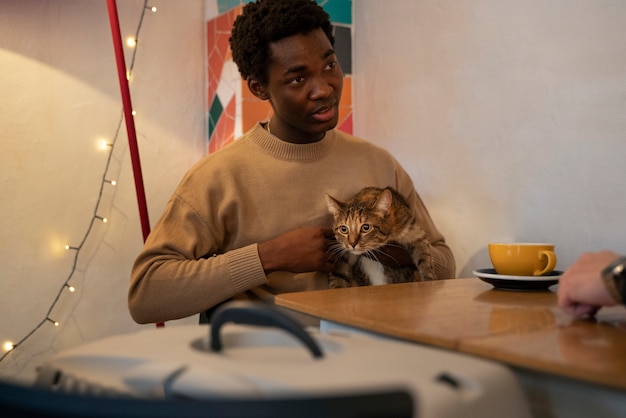How to Make Homemade Cat Litter from Natural Materials
Wiki Article

In recent years, the trend towards eco-conscious living has encompassed every element of our lives, including our cherished family pets. As family pet owners end up being significantly knowledgeable about the ecological effect of their furry good friends, the demand for natural cat litter has surged. But just what is natural cat litter, and why should pet owners consider making the switch? In this comprehensive guide, we'll delve into the world of natural cat litter to explore its advantages, alternatives, and whatever else you need to know.
As environmental awareness grows amongst animal owners, the quest for sustainable cat litter alternatives has taken spotlight. Standard clay-based litters, while popular, posture ecological issues due to their non-biodegradable nature and the ecologically extensive procedure of clay extraction. This has led to a rise in interest for eco-friendly options that promise to be kinder to the world without jeopardizing on efficiency. This article looks into the world of cat litter options, highlighting their advantages, drawbacks, and what to consider when making the switch.
Clay-based feline litters, particularly those that are non-clumping, have actually been the go-to choice for decades due to their absorbency and smell control homes. However, their ecological footprint is concerning. The mining of salt bentonite, an essential component in clumping clay litter, is disruptive to environments. Additionally, these litters do not deteriorate, contributing to land fill waste. Furthermore, the dust from clay litters can be harmful to both human and feline respiratory systems, triggering animal owners to seek much healthier, more sustainable alternatives.
Naturally degradable alternatives are made from a variety of plant-based products, including recycled paper, wood pellets, corn, wheat, and walnut shells. These materials not just break down naturally in the environment however also typically come from eco-friendly resources, minimizing the environmental effect associated with their usage.
Recycled Paper Litter is made from post-consumer paper waste, became pellets or granules. It's highly absorbent, practically dust-free, and ideal for felines and owners with respiratory level of sensitivities. However, it might not control smells as effectively as other products and typically does not clump.
Wood Pellets, sourced from lumber scraps, provide a natural pine scent that reduces the effects of smells without artificial scents. They're low in dust and take in moisture well, developing into sawdust when wet. The sawdust can be sifted out, cat litter box making the litter last longer, though some felines may not choose the bigger pellet size.
Corn and Wheat Litter are known for their clumping capability, comparable to clay litters, making clean-up simple. They're naturally degradable and compostable, with natural enzymes that assist manage smells. However, they can be costlier than traditional litter and might bring in bugs if not kept effectively.
Walnut Shell Litter utilizes the natural absorbency of crushed walnut shells, providing outstanding smell control and clumping residential or commercial properties. It's dust-free and eco-friendly but can be more costly and might not be appropriate for felines with nut allergies.
Silica gel litter, made from silica dioxide sand, oxygen, and water, is another alternative to clay. It's extremely absorbent, manages smells effectively, and is low dust. While not naturally degradable, it's lighter and can last longer than clay litter, needing less frequent changes. However, its greater rate point and the texture, which some cats may find off-putting, are factors to consider for possible users.
Felines can be particular about their litter. Slowly cat litter box furniture introduce the new litter by blending it with the old, increasing the percentage of the new litter in time to enable your feline to change.
Ecological Effect: Think about the lifecycle of the litter material, from production to disposal, to ensure it aligns with your ecological worths.
Health and wellness: cat litter crystals Choose dust-free or low-dust choices to safeguard both your and your feline's breathing health. Ensure the litter is devoid of chemicals or fragrances that could harm your animal.
Cost: While some options might be more costly in advance, their durability and the quantity needed per modification can make them cost-efficient in the long run.
The Future of Cat Litter Alternatives
The trend towards sustainable pet care products is growing, with innovations in cat litter alternatives blazing a trail. Future developments may include more efficient naturally degradable materials, improved odor control and clumping technologies, and even litter made from upcycled waste products. As consumer need for eco-friendly products boosts, we can anticipate to see a wider variety of options that do not compromise on benefit or efficiency.
The shift towards sustainable cat litter options is not simply a pattern but a reflection of a growing awareness of environmental issues among pet owners. While standard clay litters have actually controlled the market for many years, the variety of naturally degradable and ingenious products now readily available deals appealing choices for those seeking to minimize their environmental footprint. By considering factors such as ecological impact, health and safety, and feline approval, animal owners can make informed choices that benefit both their furry buddies and the planet. As the industry progresses, the future of cat litter looks greener than ever, guaranteeing a win-win circumstance for cats, their owners, and the environment.